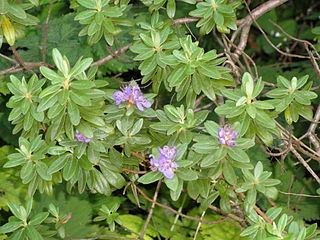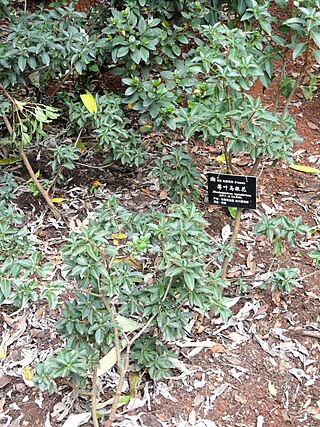
Traditional to botanical taxonomy, subdivisions of taxonomic ranks further divide subgenera, sections, and subsections into species and subspecies/varieties. Genus Rhododendron consists of eight subgenera based on morphology; this page refers to only those lower divisions in subgenus Rhododendron , commonly known as the scaly or lepidote rhododendrons. Molecular evidence suggests that the subgenus Rhododendron is monophyletic, and the section Vireya is monophyletic as well with section Pogonanthum being nested within section Rhododendron . [1] As evidenced by the following list, many subsections contain only one species, and many contain only one species that is followed by subspecies or varieties. Criteria for division into subsections may be subjective based on morphology[ citation needed ]. Recent studies have suggested a revision to the name of section Vireya; the section Vireya is referred to as Schistanthe , but contains all the subsections associated with the previous name. In this article, the two can be used interchangeably. [2]
Contents
This list does not include known hybrids; because rhododendrons are known to hybridize readily, hybrid species are numerous and are not referenced in this list.
| Number of Subsections | Number of species | |
| Pogonanthum | 0 | 16 |
| Rhododendron | 28 | 179 |
| Vireya/Schistanthe | 7 | 183 |
- subgenus Rhododendron
- section Pogonanthum
- Rhododendron anthopogon
- Rhododendron anthopogonoides
- Rhododendron cephalanthum
- Rhododendron collettianum
- Rhododendron fragrans
- Rhododendron kongboense
- Rhododendron laudandum
- Rhododendron primuliflorum
- Rhododendron sargentianum
- Rhododendron trichostomum
- Rhododendron rufescens
- Rhododendron pogonophyllum
- Rhododendron radendum
- section Rhododendron
- subsection Afghanica
- subsection Baileya
- subsection Boothia
- subsection Camelliiflora
- subsection Campylogynum
- subsection Caroliniana
- subsection Cinnabarinum
- subsection Edgeworthia
- subsection Fragariflora
- subsection Genestieriana
- subsection Glauca
- subsection Heliolepida
- subsection Lapponica
- Rhododendron bulu
- Rhododendron capitatum
- Rhododendron complexum
- Rhododendron cuneatum
- Rhododendron dasypetalum
- Rhododendron fastigiatum
- Rhododendron flavidum
- Rhododendron hippophaeoides
- Rhododendron impeditum
- Rhododendron intricatum
- Rhododendron lapponicum
- Rhododendron nitidulum
- Rhododendron nivale
- Rhododendron orthocladum
- Rhododendron polycladum
- Rhododendron rupicola
- Rhododendron russatum
- Rhododendron setosum
- Rhododendron tapetiforme
- Rhododendron telmateium
- Rhododendron thymiflolium
- Rhododendron tsaii
- Rhododendron websterianum
- Rhododendron yungningense
- subsection Ledum
- subsection Lepidota
- subsection Maddenia
- Rhododendron burmanicum
- Rhododendron carneum
- Rhododendron ciliatum
- Rhododendron coxianum
- Rhododendron dalhousiae
- Rhododendron dendricola
- Rhododendron excellens
- Rhododendron fletcherianum
- Rhododendron formosum
- Rhododendron horlickianum
- Rhododendron johnstoneanum
- Rhododendron leptocladon
- Rhododendron levinei
- Rhododendron liliiflorum
- Rhododendron lindleyi
- Rhododendron ludwigianum
- Rhododendron lyi
- Rhododendron maddenii
- Rhododendron megacalyx
- Rhododendron nuttallii
- Rhododendron pachypodum
- Rhododendron pseudociliipes
- Rhododendron roseatum
- Rhododendron scopulorum
- Rhododendron taggianum
- Rhododendron valentinianum
- Rhododendron veitchianum
- Rhododendron walongense
- subsection Micrantha
- subsection Monantha
- subsection Moupinensia
- subsection Rhododendron
- subsection Rhodorastra
- subsection Saluenensia
- subsection Scabrifolia
- subsection Tephropepia
- subsection Trichoclada
- subsection Triflora
- Rhododendron ambiguum
- Rhododendron augustinii
- Rhododendron bivelatum
- Rhododendron concinnum
- Rhododendron keiskei
- Rhododendron keiskei var. keiski
- Rhododendron keiskei var. ozawae
- Rhododendron lutescens
- Rhododendron polylepis
- Rhododendron seariane
- Rhododendron trichanthum
- Rhododendron triflorum
- Rhododendron zaleucum
- Rhododendron davidsonianum
- Rhododendron rigidum
- Rhododendron siderophyllum
- Rhododendron tatsienense
- Rhododendron yunnanense
- Rhododendron oreotrephes
- subsection Uniflora
- subsection Virgata
- section Vireya/Schistanthe
- subsection Euvireya
- Malesia group
- Rhododendron abietifolium
- Rhododendron acrophilum
- Rhododendron bagobonum
- Rhododendron brassii
- Rhododendron burttii
- Rhododendron buxifolium
- Rhododendron citrinum
- Rhododendron commonae
- Rhododendron cornu-bovis
- Rhododendron flavoviride
- Rhododendron helodes
- Rhododendron inconspicuum
- Rhododendron meijeri
- Rhododendron multicolor
- Rhododendron nieuwenhuisii
- Rhododendron pauciflorum
- Rhododendron pseudobuxifolium
- Rhododendron pubigermen
- Rhododendron rhodostomum
- Rhododendron rousei
- Rhododendron stevensianum
- Rhododendron subcrenulatum
- Rhododendron subuliferum
- Rhododendron taxifolium
- Rhododendron tuhanensis
- Rhododendron vidalii
- Rhododendron vitis-idaea
- Rhododendron wrightianum
- Solenovireya group
- Rhododendron alborugosum
- Rhododendron archboldianum
- Rhododendron armitii
- Rhododendron carrii
- Rhododendron carringtoniae
- Rhododendron cruttwellii
- Rhododendron edanoi
- Rhododendron goodenoughii
- Rhododendron jasminiflorum
- Rhododendron lambianum
- Rhododendron loranthiflorum
- Rhododendron majus
- Rhododendron multinervium
- Rhododendron niveoflorum
- Rhododendron pleianthum
- Rhododendron radians
- Rhododendron rhodoleucum
- Rhododendron roseiflorum
- Rhododendron ruttenii
- Rhododendron stapfianum
- Rhododendron suaveolens
- Rhododendron tuba
- Euvireya group
- Rhododendron alticola
- Rhododendron arfakianum
- Rhododendron aurigeranum
- Rhododendron baconii
- Rhododendron baenitzianum
- Rhododendron blackii
- Rhododendron bloembergenii
- Rhododendron celebicum
- Rhododendron christianae
- Rhododendron crassifolium
- Rhododendron culminicola
- Rhododendron curviflorum
- Rhododendron exuberans
- Rhododendron glabriflorum
- Rhododendron impositum
- Rhododendron intranervatum
- Rhododendron javanicum
- Rhododendron kochii
- Rhododendron laetum
- Rhododendron lanceolatum
- Rhododendron leptobrachion
- Rhododendron leucogigas
- Rhododendron lochiae
- Rhododendron longiflorum
- Rhododendron lowii
- Rhododendron luraluense
- Rhododendron macgregoriae
- Rhododendron madulidii
- Rhododendron maxwellii
- Rhododendron mendumiae
- Rhododendron nervulosum
- Rhododendron orbiculatum
- Rhododendron pachystima
- Rhododendron polyanthemum
- Rhododendron praetervisum
- Rhododendron rarilepidotum
- Rhododendron renschianum
- Rhododendron retivenium
- Rhododendron rhodopus
- Rhododendron robinsonii
- Rhododendron rugosum
- Rhododendron salicifolium
- Rhododendron scabridibracteum
- Rhododendron seranicum
- Rhododendron sessilifolium
- Rhododendron stenophylum
- Rhododendron sumatranum
- Rhododendron vanvuurenii
- Rhododendron verticilliatum
- Rhododendron viriosum
- Rhododendron williamsii
- Rhododendron yongii
- Rhododendron zoelleri
- Linnaeopsis group
- Saxifragoidea group
- Malesia group
- subsection Malyovireya
- subsection Discovireya
- Rhododendron adinophyllum
- Rhododendron borneense
- Rhododendron cunefolium
- Rhododendron ericoides
- Rhododendron erosipetalum
- Rhododendron gaultheriifolium
- Rhododendron lindaueanum
- Rhododendron meliphagidum
- Rhododendron monodii
- Rhododendron nanophyton
- Rhododendron nummatum
- Rhododendron perakense
- Rhododendron pulleanum
- Rhododendron quadrasianum
- Rhododendron retusum
- Rhododendron scortechinii
- subsection Pseudovireya
- subsection Siphonovireya
- subsection Albovireya
- subsection Phaeovireya
- Rhododendron beyerinckianum
- Rhododendron bryophilum
- Rhododendron caliginis
- Rhododendron dianthosmum
- Rhododendron dielsianum
- Rhododendron evelyneae
- Rhododendron eymae
- Rhododendron gardenia
- Rhododendron haematophthalmum
- Rhododendron hellwigi
- Rhododendron hyacinthosmum
- Rhododendron kawir
- Rhododendron konori
- Rhododendron leptanthum
- Rhododendron phaeochitum
- Rhododendron phaeops
- Rhododendron rarum
- Rhododendron rhodochroum
- Rhododendron rubellum
- Rhododendron solitarium
- Rhododendron superbum
- Rhododendron tintinnabellum
- Rhododendron truncicola
- Rhododendron tuberculiferum
- subsection Euvireya
- section Pogonanthum















